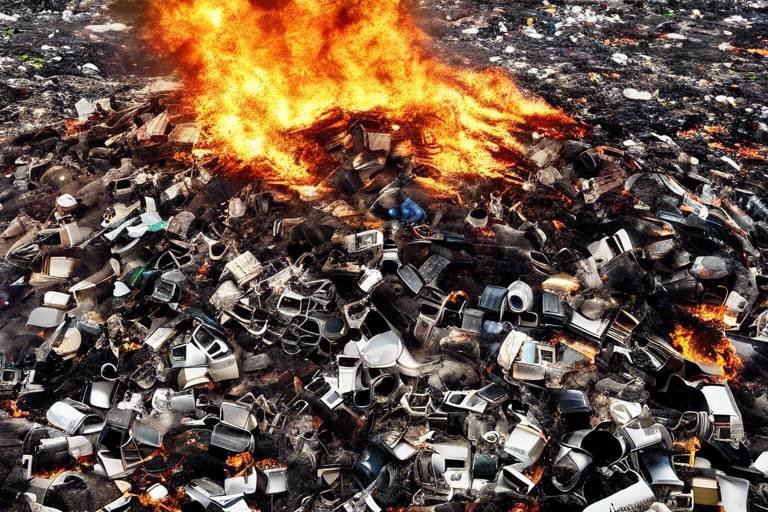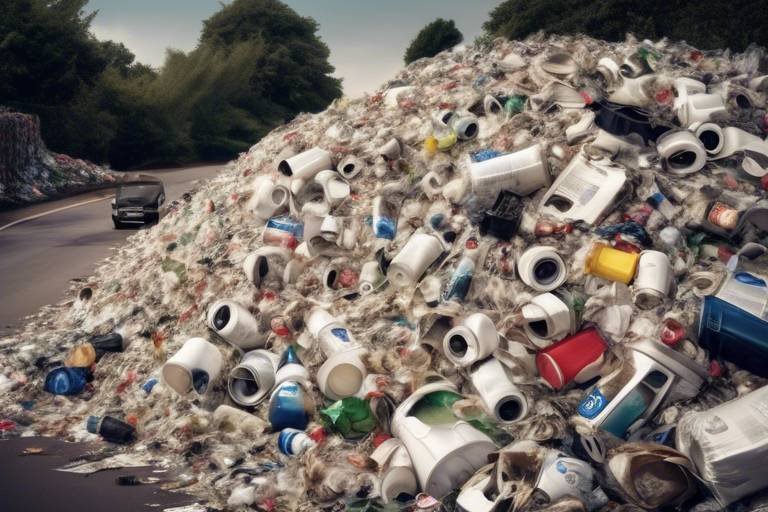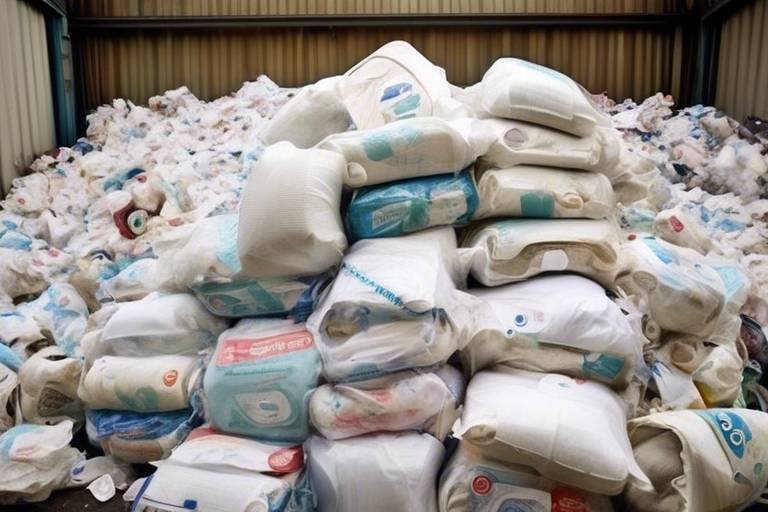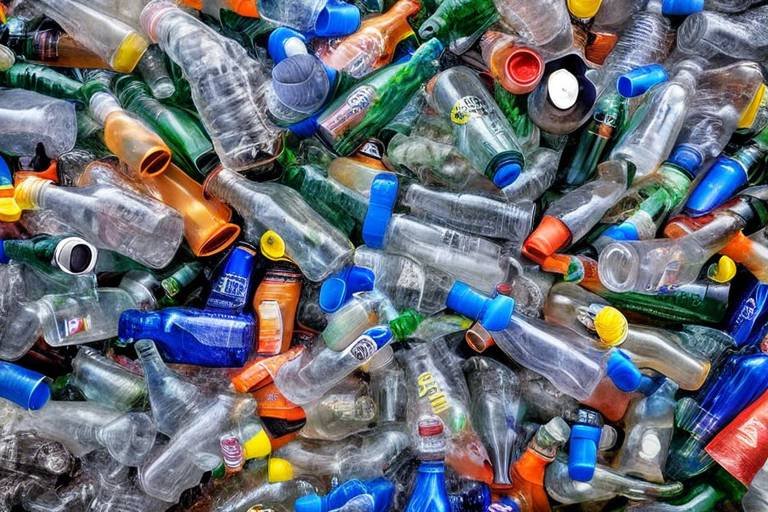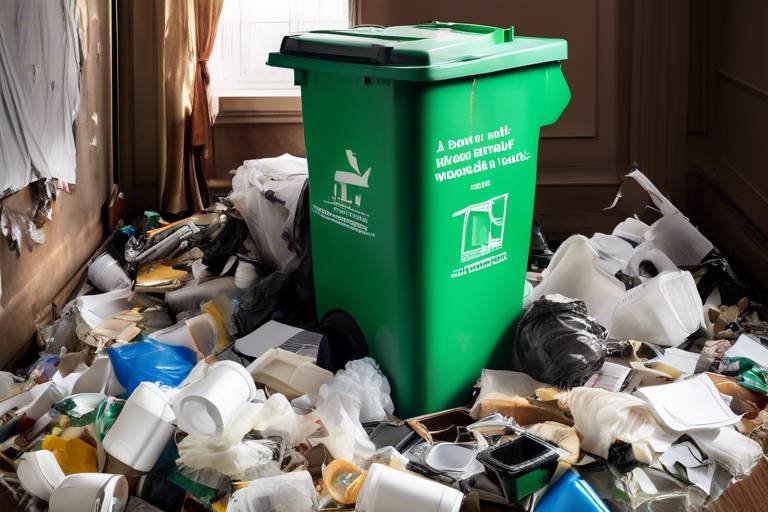Change Waste Management Habits - One Step at a Time
In today's fast-paced world, the topic of waste management is more crucial than ever. As individuals, it’s easy to overlook our personal impact on the environment, but every small change we make can lead to significant improvements. The journey to better waste management doesn’t have to be overwhelming; in fact, it can be quite simple. By taking it one step at a time, we can create lasting habits that not only benefit our planet but also inspire those around us. Are you ready to embark on this journey? Let’s dive into practical strategies that can transform your waste management habits.
To effectively change our waste management habits, we first need to understand what waste management truly entails. At its core, waste management involves the collection, transport, processing, recycling, and disposal of waste materials. This process is vital for maintaining a healthy environment and public health. Poor waste management can lead to pollution, increased greenhouse gas emissions, and a depletion of natural resources. By grasping the importance of waste management, we can better appreciate our role in this critical system and take informed steps towards improvement.
Before we can improve, we must first assess where we currently stand. Evaluating your existing waste management practices is crucial for identifying areas where change is needed. Start by observing your daily routines and the waste they generate. You might be surprised by how much waste is produced from seemingly harmless activities! Keeping a waste diary for a week can help you pinpoint waste sources and patterns. What do you throw away most often? Understanding these habits is the first step in making effective changes.
Recognizing the primary sources of waste in our daily lives is essential for strategizing reduction methods. The most common culprits include:
- Food packaging
- Single-use plastics
- Old electronics
- Unwanted clothing
By identifying these sources, we can begin to develop targeted strategies to minimize waste. For instance, reducing reliance on single-use plastics by opting for reusable bags and containers can significantly cut down on waste output.
Household waste comprises a significant portion of total waste generated. Common household items that contribute to waste include food scraps, packaging materials, and outdated electronics. To combat this, consider implementing a few simple practices:
- Reduce: Buy in bulk to minimize packaging.
- Reuse: Find new uses for items before discarding them.
- Recycle: Familiarize yourself with your local recycling guidelines.
By being mindful of our purchasing and disposal habits, we can drastically reduce the amount of waste we generate at home.
Commercial establishments also generate substantial waste, and it’s essential for businesses to adopt better waste management practices. This includes conducting regular waste audits, training employees on waste reduction techniques, and implementing recycling programs. Businesses can lead by example and inspire their customers to adopt similar practices. By reducing their environmental footprint, companies not only contribute to sustainability but can also save on disposal costs and enhance their brand image.
Establishing achievable waste reduction goals is essential for success. Instead of aiming for perfection, focus on setting specific, measurable, attainable, relevant, and time-bound (SMART) goals. For example, you might aim to reduce your household waste by 20% over the next six months. Breaking larger goals into smaller, manageable steps can make the process feel less daunting and more achievable. Remember, every little bit counts!
Now that you’ve assessed your habits and set goals, it’s time to implement practical strategies for reducing waste. Some effective methods include:
- Composting: Transform organic waste into nutrient-rich compost.
- Recycling: Familiarize yourself with local recycling guidelines.
- Choosing Sustainable Products: Opt for eco-friendly alternatives.
Implementing these strategies can significantly minimize your waste output and contribute to a healthier planet.
Composting is an effective way to manage organic waste, such as fruit and vegetable scraps, coffee grounds, and yard waste. Starting a compost bin at home is easier than you might think! Not only does composting reduce the amount of waste sent to landfills, but it also enriches your garden soil. To maintain a successful compost system, remember to balance green materials (like grass clippings) with brown materials (like dried leaves). Have you tried composting yet? If not, now is the perfect time to start!
Opting for sustainable products can drastically reduce waste. When shopping, look for items with minimal packaging, biodegradable materials, and products made from recycled content. By choosing eco-friendly alternatives, you’re not just reducing waste; you’re also supporting companies that prioritize sustainability. Every purchase is a vote for the kind of world you want to live in. What choices will you make today?
Q: How can I start reducing waste at home?
A: Begin by assessing your current waste habits, setting realistic goals, and implementing simple strategies like recycling and composting.
Q: What are the benefits of composting?
A: Composting reduces landfill waste, enriches soil, and helps retain moisture in gardens, promoting healthier plant growth.
Q: How can businesses reduce their waste output?
A: Businesses can conduct waste audits, implement recycling programs, and train employees on waste reduction practices.
Q: What are sustainable products?
A: Sustainable products are those made from eco-friendly materials, often with minimal packaging and a focus on reducing environmental impact.

Understanding Waste Management
Waste management is more than just a buzzword; it's a critical aspect of our daily lives that affects our planet's health. At its core, waste management encompasses the processes of collecting, transporting, processing, recycling, and disposing of waste materials. The importance of effective waste management cannot be overstated—it plays a pivotal role in protecting the environment, conserving resources, and enhancing public health. When we think about waste, it’s easy to overlook the significant impact our habits have on the planet. Every piece of trash we throw away contributes to a larger problem: overflowing landfills, pollution, and the depletion of natural resources.
Understanding the basics of waste management sets the foundation for making informed changes in personal and community waste practices. For instance, did you know that the average person generates about 4.4 pounds of waste per day? That’s roughly 1,600 pounds per year! This staggering statistic highlights the urgency for us to rethink how we handle waste. By grasping the various types of waste—such as organic, recyclable, and hazardous—we can start to take responsibility for our waste footprint.
Moreover, waste management is not solely an individual responsibility; it requires a collective effort from communities, businesses, and governments. When local governments implement effective waste management policies, it leads to cleaner neighborhoods, healthier ecosystems, and a more sustainable future. For example, cities that have adopted comprehensive recycling programs have seen a significant decrease in landfill waste, showcasing the positive outcomes of proactive waste management.
To further illustrate the importance of waste management, consider the following key points:
- Environmental Protection: Proper waste management helps reduce pollution and conserves natural resources, ensuring a healthier planet for future generations.
- Public Health: Effective waste disposal reduces the risk of disease transmission and promotes healthier living conditions.
- Resource Conservation: Recycling and composting help reclaim valuable materials, reducing the need for raw resource extraction.
In summary, understanding waste management is essential for anyone looking to make a positive impact on the environment. By recognizing the significance of our waste habits and the collective responsibility we share, we can begin to implement changes—no matter how small—that contribute to a more sustainable future.

Assessing Your Current Waste Habits
Before embarking on a journey to improve your waste management practices, it's essential to take a step back and assess your current waste habits. Think of it as a personal audit—just like you would check your bank account to see where your money is going, you need to examine how much waste you produce and where it comes from. This reflection not only helps you identify areas for improvement but also sets the stage for meaningful change. Are you ready to dive in?
Start by keeping a waste diary for a week. This might sound tedious, but it can be eye-opening! Jot down everything you throw away. You might be surprised at the volume and types of waste that accumulate. From food scraps to packaging, understanding the composition of your waste is the first step toward significant improvements. By categorizing your waste, you can pinpoint specific areas where you can reduce, reuse, or recycle. For instance, do you notice a lot of plastic wrappers? That could be a cue to switch to bulk buying or reusable containers.
Next, consider the common sources of waste in your daily life. Every household has its own unique waste profile, but some culprits are almost universal. Here’s a quick rundown of typical waste sources:
- Food waste: Leftovers that go uneaten or produce that spoils too quickly.
- Packaging: Boxes, plastic wraps, and containers that come with the products you buy.
- Disposable items: Think about paper towels, plastic utensils, and single-use items.
By identifying these common sources, you’ll be better equipped to strategize effective reduction methods. For example, if food waste is a significant part of your trash, consider meal planning or composting. If packaging is the issue, try to buy in bulk or choose products with minimal packaging.
Now, let’s talk about the impact of commercial waste. It’s not just households that contribute to the problem; businesses play a massive role too. If you own a business or work in one, take a moment to evaluate how waste is managed in your workplace. Are there recycling bins available? Is there a policy in place for reducing waste? Small changes in commercial practices can lead to a substantial decrease in overall waste generation.
As you assess your waste habits, remember that the goal is to set realistic and achievable targets for improvement. This process is not about perfection; it’s about progress. By understanding your current waste generation patterns, you can make informed decisions that contribute to a more sustainable future.
Q: Why is it important to assess my waste habits?
A: Assessing your waste habits helps you identify areas for improvement and develop strategies to reduce waste effectively.
Q: How can I keep track of my waste?
A: You can maintain a waste diary for a week or use apps designed to track waste generation.
Q: What are some common sources of household waste?
A: Common sources include food waste, packaging materials, and disposable items like paper towels and plastic utensils.
Q: How can businesses reduce their waste?
A: Businesses can implement recycling programs, minimize packaging, and encourage employees to adopt sustainable practices.

Identifying Common Waste Sources
When it comes to managing waste effectively, the first step is understanding where that waste is coming from. It's a bit like trying to fix a leaky faucet; you need to pinpoint the source of the leak before you can take action. In our daily lives, we generate waste from various sources, and recognizing these can help us strategize better reduction methods. So, what are the common culprits contributing to our overflowing trash bins?
One of the biggest contributors to waste is household items. Think about it: every time you open your fridge, grab a snack, or clean your home, you're likely adding to your waste pile. Items like food wrappers, packaging materials, and disposable products accumulate quickly. For instance, plastic bags, which most of us use without a second thought, can take hundreds of years to decompose in a landfill. This not only clogs up our waste systems but also harms wildlife and the environment.
In addition to household waste, we also have to consider commercial waste. Businesses, from restaurants to retail stores, generate a significant amount of waste daily. This can include everything from food scraps and packaging to office supplies and outdated inventory. The impact of this waste is substantial, as commercial establishments often have larger waste outputs compared to individual households. For example, a typical restaurant can produce thousands of pounds of waste each month, much of which could be composted or recycled instead of heading to the landfill.
Now, let's dive deeper into some specific categories of waste that we encounter regularly:
- Packaging Waste: This includes everything from plastic containers to cardboard boxes. With online shopping on the rise, packaging waste has skyrocketed.
- Food Waste: Uneaten food, expired items, and leftovers often end up in the trash. It's estimated that a significant portion of the food we purchase is wasted.
- Plastic Waste: Single-use plastics, such as straws, cutlery, and bottles, are notorious for their environmental impact. They are convenient but come at a high cost to the planet.
By identifying these common sources of waste, we can start to make informed decisions about how to reduce our waste footprint. It’s like putting together a puzzle; once you have all the pieces, you can see the bigger picture and figure out where to make changes. Whether it's opting for reusable bags, composting food scraps, or encouraging businesses to adopt sustainable practices, every small change can lead to significant environmental benefits.
So, the next time you toss something in the trash, take a moment to think about its journey. By recognizing the sources of our waste, we empower ourselves to make better choices that contribute to a more sustainable future.
Q: What is the most common type of waste generated in households?
A: The most common type of waste in households includes food waste, packaging materials, and single-use plastics.
Q: How can I reduce food waste at home?
A: You can reduce food waste by planning meals, storing food properly, and composting leftovers.
Q: What are some sustainable alternatives to single-use plastics?
A: Consider using reusable bags, glass containers, and metal straws as sustainable alternatives to single-use plastics.
Q: How can businesses reduce their waste output?
A: Businesses can reduce waste by implementing recycling programs, minimizing packaging, and donating excess food.

Household Waste
When we think about waste, our minds often drift to the larger issues like industrial pollution or landfill overflow. However, the truth is, is a significant contributor to the overall waste problem we face today. In fact, did you know that the average household generates around 4.4 pounds of waste per person per day? That's a staggering amount when you consider the millions of households across the globe!
Household waste includes everything from food scraps and packaging materials to old electronics and clothes. Each of these items contributes to the growing mountain of waste that ends up in landfills, where they can take years—if not centuries—to decompose. The impact of this waste on our environment is profound, leading to issues such as soil contamination, water pollution, and increased greenhouse gas emissions. So, what can we do to tackle this problem right from our homes?
One of the first steps is to identify the types of waste we generate. Common household items that contribute significantly to waste include:
- Food Waste: Leftovers, expired groceries, and peels make up a large portion of our waste.
- Packaging: Plastic wrappers, cardboard boxes, and glass bottles often end up in the trash.
- Electronics: Old gadgets and appliances are frequently discarded without proper recycling.
- Textiles: Clothes that no longer fit or are out of style often get tossed aside.
Reducing household waste starts with awareness. By keeping track of what we throw away, we can begin to see patterns and identify areas for improvement. For example, if you find that a lot of your waste comes from food, it might be time to rethink your shopping habits. Are you buying more than you need? Are you storing food properly to prevent spoilage?
Another effective strategy is to adopt a minimalist mindset. By focusing on purchasing only what you truly need, you can significantly cut down on waste. Consider asking yourself if you really need that new gadget or piece of clothing before making a purchase. Additionally, embracing the idea of upcycling—transforming old items into something new—can extend the life of products and reduce waste.
Furthermore, recycling plays a crucial role in managing household waste. Make sure to familiarize yourself with your local recycling guidelines. Some common recyclable materials include:
- Paper and cardboard
- Glass bottles and jars
- Certain plastics (check for recycling symbols)
Setting up a designated recycling station in your home can make it easier to sort and manage waste. By taking these small steps, you can not only reduce the amount of waste your household generates but also inspire others in your community to do the same.
In conclusion, tackling household waste is not just an individual effort; it's a collective movement towards a more sustainable future. Each small change we make can lead to significant impacts, and by being mindful of our waste habits, we can contribute to a healthier planet for generations to come.

Commercial Waste
When we think about waste, our minds often drift toward the clutter in our homes or the trash bags we toss out every week. However, is a significant player in the waste generation game, and it’s time we shine a light on it. Businesses, from small shops to large corporations, produce a staggering amount of waste, contributing to environmental degradation and resource depletion. In fact, commercial waste can account for up to 70% of total waste in urban areas. This is a wake-up call for businesses to rethink their waste management practices.
So, what exactly constitutes commercial waste? It includes everything from packaging materials and food waste in restaurants to office supplies and electronic waste in corporate offices. The sheer volume of waste generated by these entities is not just a statistic; it has real-world implications. For instance, if businesses do not adopt sustainable practices, they risk contributing to overflowing landfills and increased pollution.
But here’s the good news: businesses have the power to implement effective waste management strategies that not only reduce their environmental footprint but also save money in the long run. By adopting practices such as recycling, composting, and reducing single-use products, companies can significantly decrease their waste output. Consider this a two-for-one deal: less waste means lower disposal costs and a positive brand image that attracts eco-conscious customers.
To get started, businesses should conduct a thorough waste audit. This process involves analyzing the types and volumes of waste produced, which can reveal opportunities for improvement. Here’s a simple breakdown of common waste types generated in commercial settings:
| Type of Waste | Examples | Reduction Strategies |
|---|---|---|
| Packaging Waste | Boxes, plastic wrap, bubble wrap | Use bulk purchasing, switch to biodegradable packaging |
| Food Waste | Unserved meals, expired products | Implement better inventory management, donate surplus food |
| Office Waste | Papers, plastics, electronic waste | Go digital, recycle old electronics, reduce paper use |
By addressing these common waste sources, businesses can make significant strides toward sustainability. It’s essential to engage employees in these efforts, fostering a culture of responsibility and awareness. Training sessions and workshops can be instrumental in educating staff about the importance of waste reduction and how they can contribute.
Moreover, businesses can collaborate with local recycling programs and waste management services to ensure that their waste is handled responsibly. By partnering with organizations that specialize in sustainable practices, companies can stay ahead of the curve and demonstrate their commitment to the environment.
In conclusion, tackling commercial waste is not just an option; it’s a necessity. By embracing sustainable practices, businesses can lead the charge toward a greener future while reaping the benefits of reduced costs and enhanced reputation. The time for action is now, and every small step counts!
- What is commercial waste? Commercial waste refers to the waste generated by businesses, including packaging, food waste, and office supplies.
- How can businesses reduce commercial waste? Businesses can reduce waste by implementing recycling programs, composting organic waste, and choosing sustainable packaging.
- Why is it important for businesses to manage waste? Proper waste management helps reduce environmental impact, lowers disposal costs, and improves brand reputation.
- What is a waste audit? A waste audit is an analysis of the types and volumes of waste generated by a business to identify areas for improvement.

Setting Realistic Goals
When it comes to changing waste management habits, is your secret weapon. Think of it as a journey rather than a sprint. Just like you wouldn't run a marathon without training, you shouldn't leap into drastic changes without a plan. The key is to start small and build momentum over time. This way, you can create lasting habits without feeling overwhelmed.
First, let's talk about the SMART criteria, which stands for Specific, Measurable, Attainable, Relevant, and Time-bound. By using this framework, you can ensure your goals are not only realistic but also effective. For example, instead of saying, "I want to reduce my waste," a SMART goal would be, "I will reduce my household waste by 20% over the next six months by recycling, composting, and purchasing fewer single-use items." This approach gives you a clear target and a timeline, making it easier to track your progress.
It's also important to assess your current habits before setting goals. Take a week to observe what you throw away. Are there patterns? Are there specific items that consistently end up in the trash? By identifying these, you can create targeted goals. For instance, if you notice that a lot of food waste is being generated, a goal could be to implement a meal planning system that minimizes leftovers and spoilage.
Another effective strategy is to enlist the help of family or friends. When you share your goals with others, it creates a support system that can motivate you to stay on track. Consider organizing a monthly check-in, where you can discuss your progress and challenges. This not only helps keep you accountable but also fosters a sense of community around waste reduction efforts.
As you set your goals, don't forget to celebrate the small victories! Every bit counts, and acknowledging your progress can boost your motivation. For example, if you successfully reduce plastic usage for a month, treat yourself to a little reward—perhaps a nice dinner or a new plant for your home. Positive reinforcement can be incredibly powerful in building new habits.
Lastly, be flexible with your goals. Life happens, and sometimes you may not meet your targets. Instead of feeling discouraged, reassess and adjust your goals as necessary. Perhaps you aimed to reduce your waste by 50% in three months, but only managed 30%. That’s still a significant achievement! Use it as a stepping stone to refine your strategies and push forward.
- How do I know if my goals are realistic? Start by evaluating your current waste habits and set incremental goals that challenge but don't overwhelm you.
- What if I fail to meet my waste reduction goals? It's okay! Use it as a learning experience, reassess your strategies, and adjust your goals as needed.
- Can I set goals for my community? Absolutely! Collaborating with neighbors or local groups can amplify your impact and create a supportive environment.

Implementing Waste Reduction Strategies
When it comes to reducing waste, the journey can feel overwhelming. However, taking it one step at a time can lead to big changes! Implementing waste reduction strategies is not just about making a few tweaks here and there; it's about creating a sustainable lifestyle that benefits both you and the environment. So, how do we start?
First off, let's talk about the power of composting. This method is a fantastic way to manage organic waste, such as fruit and vegetable scraps, coffee grounds, and even yard waste. By composting at home, you can significantly reduce the amount of waste that ends up in landfills. Not only does composting help divert waste, but it also produces nutrient-rich soil that can enhance your garden. To get started, you’ll need a compost bin, which can be as simple as a pile in your backyard or a designated container under your sink. The key is to maintain a balance of 'greens' (nitrogen-rich materials) and 'browns' (carbon-rich materials) to create a thriving compost environment. Here’s a quick overview of what you can compost:
| Green Materials | Brown Materials |
|---|---|
| Fruit and vegetable scraps | Dry leaves |
| Coffee grounds | Cardboard |
| Grass clippings | Paper (non-glossy) |
Another effective strategy is to choose sustainable alternatives. This means opting for products that are designed to minimize waste. For instance, instead of buying bottled water, consider investing in a reusable water bottle. Not only does this cut down on plastic waste, but it also saves you money in the long run! When shopping, look for items with minimal packaging or those made from recycled materials. By making conscious choices, you can significantly reduce your overall waste footprint.
But wait, there’s more! Have you ever thought about reducing single-use items? Items like plastic bags, straws, and utensils contribute massively to global waste. By switching to reusable options, you’re not just making a personal change; you’re also setting an example for others. Imagine a world where everyone carries their own reusable shopping bags or sips their drinks with a metal straw. Sounds good, right? It’s all about creating a ripple effect.
Furthermore, consider implementing a waste audit at home. This involves tracking your waste for a week to see what you throw away the most. By identifying the biggest culprits, you can tailor your waste reduction strategies accordingly. Are you tossing out a lot of food? Maybe meal planning could help! Is your recycling bin overflowing? Perhaps it’s time to get serious about reducing your consumption of packaged goods.
In conclusion, implementing waste reduction strategies is not just a personal challenge; it’s a collective movement toward a more sustainable future. By composting, choosing sustainable alternatives, reducing single-use items, and conducting waste audits, we can all contribute to a cleaner, greener planet. Remember, every small step counts!
Q: What can I compost at home?
A: You can compost fruit and vegetable scraps, coffee grounds, grass clippings, and dry leaves. Avoid composting meat, dairy, and oily foods.
Q: How can I identify sustainable products?
A: Look for products with minimal packaging, made from recycled materials, or certified by eco-labels like Energy Star or Fair Trade.
Q: Is composting difficult to maintain?
A: Not at all! With the right balance of materials and regular turning, composting can be easy and rewarding.

Composting at Home
Composting at home is not just a trend; it's a transformative practice that can significantly reduce the amount of waste we send to landfills. Imagine turning your kitchen scraps into nutrient-rich soil for your garden! It's like giving back to the earth while simultaneously cutting down on your waste. By composting, you’re not only minimizing garbage but also enriching your soil, which is a win-win situation.
To start composting, you don’t need a fancy setup. A simple bin or even a pile in your backyard can work wonders. The key is to understand what materials are compostable. Generally, you can compost:
- Fruit and vegetable scraps - These are the stars of your compost pile!
- Eggshells - They add calcium to your compost.
- Coffee grounds - A great source of nitrogen.
- Grass clippings and leaves - These provide carbon and help balance the compost.
However, not everything can go into your compost. Avoid adding meat, dairy, or oily foods as they can attract pests and create odors. Think of your compost bin as a delicate ecosystem where balance is key. When you manage to strike that balance, the magic happens. You’ll notice that your food scraps decompose into dark, rich compost that can be used to nourish your plants.
One of the most rewarding aspects of composting is the benefits it brings. Not only does it reduce the volume of waste you produce, but it also:
- Reduces greenhouse gas emissions by keeping organic waste out of landfills.
- Improves soil health, which can lead to healthier plants and gardens.
- Conserves water by enhancing soil structure and moisture retention.
To maintain a successful compost system, remember to turn your compost regularly. This aerates the pile and speeds up the decomposition process. If you notice a foul smell, it might be too wet or have too much nitrogen. In that case, add more carbon-rich materials like dried leaves or shredded paper. Think of it as a recipe; getting the right mix is essential for a successful outcome!
In conclusion, composting at home is a simple yet powerful way to contribute to waste reduction. It’s about making small, manageable changes that lead to significant environmental benefits. So why not give it a try? You might find that it not only helps the planet but also enhances your gardening experience!
1. What can I compost?
Most kitchen scraps like fruits, vegetables, coffee grounds, and eggshells can be composted. Just avoid meat, dairy, and oils.
2. How long does it take for compost to be ready?
Typically, compost takes about 3 to 6 months to break down, depending on conditions like temperature and moisture.
3. Can I compost in an apartment?
Absolutely! You can use a compost bin designed for small spaces or even a worm composter (vermicomposting) to turn your scraps into compost.
4. What if my compost smells bad?
A bad smell usually indicates that the compost is too wet or has too much nitrogen. Add dry materials like leaves or cardboard to balance it out.

Choosing Sustainable Alternatives
In our quest for a greener planet, one of the most impactful steps we can take is in our daily lives. It’s a bit like swapping out a gas-guzzling car for a sleek, electric model; the change might seem small at first, but the ripple effect can be monumental. By making conscious choices about the products we use, we can significantly reduce our waste footprint and contribute to a healthier environment.
So, what does it mean to choose sustainable alternatives? Essentially, it involves selecting products that are made from renewable resources, are biodegradable, or have minimal environmental impact. This could mean opting for reusable bags instead of single-use plastic ones, or choosing bamboo toothbrushes over traditional plastic ones. The beauty of these alternatives is that they not only help reduce waste but often come with the added bonus of being healthier for us and our planet.
To illustrate the impact of these choices, let’s consider a few common household items:
| Conventional Product | Sustainable Alternative | Environmental Benefit |
|---|---|---|
| Plastic Water Bottles | Reusable Water Bottles | Reduces plastic waste and saves resources |
| Paper Towels | Cloth Napkins | Minimizes paper waste and promotes reuse |
| Conventional Cleaning Products | Eco-friendly Cleaning Solutions | Less harmful chemicals released into the environment |
When you choose sustainable products, you’re not just making a personal choice; you’re voting with your wallet for a healthier planet. It’s a way of saying, “I care about the future of our environment.” But how do we identify these eco-friendly alternatives? Look for certifications such as Fair Trade, USDA Organic, or Energy Star ratings. These labels can guide you in making informed decisions that align with your sustainability goals.
Moreover, it’s essential to remember that sustainability isn’t just about the products we buy; it’s also about how we use them. For instance, even the most eco-friendly product can become wasteful if used irresponsibly. Therefore, adopting practices like repairing instead of replacing, or sharing resources with others can further enhance our commitment to sustainability. Think of it as creating a ripple effect; each small change contributes to a larger wave of positive impact.
In conclusion, choosing sustainable alternatives is not merely a trend; it’s a lifestyle shift that can lead to significant environmental benefits. By being mindful of our choices, we not only reduce waste but also pave the way for a more sustainable future. So, the next time you’re about to make a purchase, ask yourself: “Is there a greener option?” You may be surprised at how easy it is to make a difference, one sustainable choice at a time.
- What are sustainable products? Sustainable products are those that have a minimal impact on the environment, often made from renewable resources or designed to be reused or recycled.
- How can I identify eco-friendly products? Look for certifications like Fair Trade, USDA Organic, or Energy Star, which indicate that the products meet specific environmental standards.
- Why is it important to choose sustainable alternatives? Choosing sustainable alternatives helps reduce waste, conserve resources, and protect the environment for future generations.
Frequently Asked Questions
- What is waste management and why is it important?
Waste management refers to the collection, transportation, processing, and disposal of waste materials. It's crucial because improper waste management can lead to environmental pollution, health hazards, and depletion of natural resources. By managing waste effectively, we can protect our planet and promote sustainability.
- How can I assess my current waste habits?
Start by keeping a waste diary for a week. Note what you throw away, including food scraps, packaging, and other items. This will help you identify key areas where you can cut back. You can also categorize your waste into recyclables, compostables, and trash to see where improvements can be made.
- What are some common sources of household waste?
Common sources include food packaging, single-use plastics, old electronics, and clothing. By recognizing these culprits, you can take steps to reduce their impact, such as opting for bulk purchases, recycling, and donating items you no longer need.
- How can businesses improve their waste management practices?
Businesses can conduct waste audits to identify waste generation patterns, implement recycling programs, and train employees on sustainable practices. Additionally, they can choose sustainable suppliers and products to minimize waste from the outset.
- What are SMART goals in waste management?
SMART goals are Specific, Measurable, Achievable, Relevant, and Time-bound objectives that help you track your waste reduction efforts. For example, instead of saying "I want to reduce waste," a SMART goal would be "I will reduce my plastic waste by 50% in the next six months by using reusable bags and containers."
- How do I start composting at home?
Begin by selecting a compost bin or pile in your yard. Collect organic waste like vegetable scraps, coffee grounds, and yard waste. Layer these materials, ensuring a mix of greens (nitrogen-rich) and browns (carbon-rich). Turn your compost regularly to aerate it, and in a few months, you’ll have rich compost ready for your garden!
- What are some sustainable alternatives I can choose?
Sustainable alternatives include using reusable shopping bags, bamboo toothbrushes, and glass or stainless steel containers. Look for products with minimal packaging and those made from recycled materials. This not only reduces waste but also supports eco-friendly businesses.


